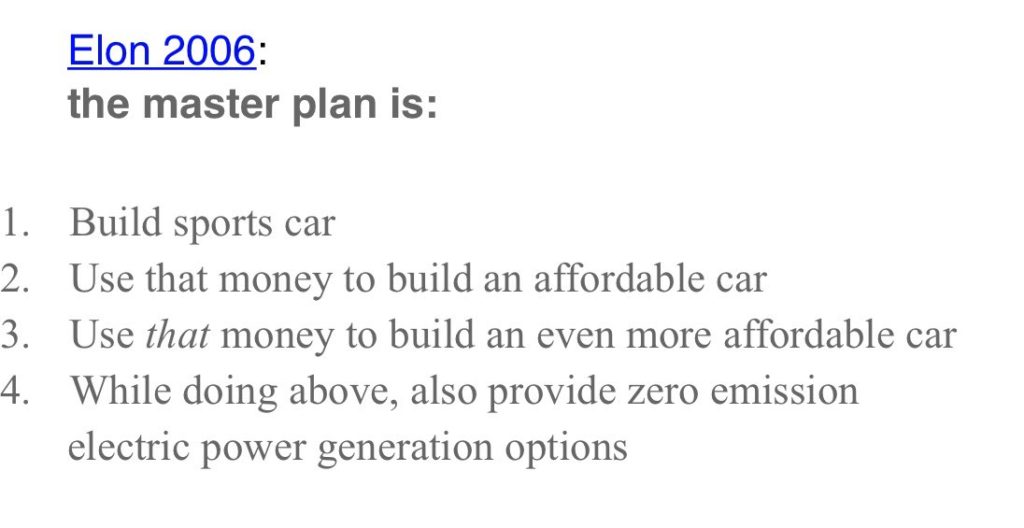Entrepreneurs
5 Elon Musk Approved Tips for Entrepreneurs

Elon Musk is quite possibly the poster child of entrepreneurship. With a following that verges almost into a cult-like stature, Musk is notorious for doing things that people say can’t be done. The most futuristic entrepreneur yet, he has (to date) launched a record 64 satellites into orbit, is digging a tunnel deep underground to deal with traffic congestion and plans on setting a human colony on Mars by 2030.
A titan, in his own rights, Elon Musk’s success can be attributed to anything but luck. Here’s what makes Elon stand apart from the rest of the crowd and what enables him to dominate the four major sectors (automobile, space, construction, solar energy):
1. Fixate On A Goal
For Musk, his ultimate goal is to make human beings an interplanetary species. Everything else is just stepping stones to his one significant life’s purpose. As the below snapshot from Elon’s diary (way back in 2006) exhibits, Musk isn’t afraid of putting his all power, resources, focus, and determination into accomplishing his goals.

Here’s the thing about Musk, when he decides to go after a goal, he puts a lot of effort and time into understanding the goal. Once he has set the goal, he decides to learn everything about it that there is to know. Before founding SpaceX, he had no idea how to go about building rockets. So he decided to hire people who actually knew about rockets and read all that there is to know about space travel.
Musk’s visions might be too great but the fact is that he works incredibly hard. He cannot conceive the idea of not achieving what he set out to do and perhaps this kind of optimism is required to truly succeed as he eventually does.
2. Excruciating Effort
Musk: So, as a startup, a car company, it is far more difficult to be successful than if you’re an established, entrenched brand. It is absurd that Tesla is alive. Absurd! Absurd.”
Interviewer: What do you credit that to?
Musk: Excruciating effort.
This excerpt from an interview portrays the levels Elon Musk goes to make his companies stay profitable. For Musk, failure is not a reason to stop doing what he loves. From Tesla being almost bankrupt to the Cybertruck, Musk has taken more risks than the average founder. Call it an unshakeable optimism or sheer foolishness, this tactic seems to have worked well with him.
For Elon Musk failure at the beginning of his ventures are inevitable and is necessary to succeed. Musk demonstrates the ability to take failure at a face value and doesn’t let things like the glass of the Cybertruck shattering in a globally televised event as a particular reason to stop.
For future and present entrepreneurs, Musk’s attitude towards obstacles is the outlook towards life that you should have. It’s extremely necessary to build a thick skin as well as having the grit to progress beyond the failures.
3. Hire The Right People
An alleged copy of Tesla’s “Anti-Handbook Handbook” for new hires was leaked recently. It reflected the high standards that Musk holds up to Tesla’s new hires:
The main theme behind the handbook seems to be ideal that Musk holds to every employee: as invested in Tesla as Musk is. Tesla hires people not based on their resume but skills. If you are a Tesla employee, you are expected to do everything in your power to give your best performance. That includes directly reaching out to Musk to share any new ideas and knowledge.
While top employees will certainly be with you during your highs, you need dedicated employees to ride out the lows. And that’s what Tesla does perfectly.
4. Have An Unshakeable Work Ethic
Elon Musk’s work ethic is near-impossible to follow. But it is certainly something to take inspiration from. Musk reportedly clocked in a whopping 100 hours a week for 15 years. When a week is particularly hard, he exceeds up to 120 hours a week and is also found sleeping on the factory’s floor. According to Musk:“There are way easier places to work, but nobody ever changed the world on 40 hours a week.”
While this lifestyle is not feasible for everyone, the key factor in this is Musk’s determination to get things done. You don’t need to invest crazy hours at work (unless you are running four companies like Elon Musk) but you do need to do things when they need to be done. It’s about keeping your priorities straight and implementing things that’ll propel your company forward.
5. Look For Problem Areas
People like to actively complain about things. Not Elon Musk. When Musk grew frustrated about the traffic problems that he faced, he started The Boring Company. The Boring Company aims to solve the traffic congestion problem by building a tunnel system.
To become a successful entrepreneur, find problems that need to be solved. Seeking out problems that need to be solved is a great way to find ideas about problems that people actually need some solution to.
While Musk’s incredible work ethic plays a great role in his success, it is his ability to solve difficult problems. In other words, the recipe for success is not in how hard you work but is actually about how you think.
Change Your Mindset
The Silent Skill That Makes People Respect You Instantly
What truly earns respect and why most people go about it the wrong way

Everybody craves respect but not everyone earns it. Some people believe that a title, years of experience, or a position of authority automatically entitles them to respect. (more…)
Entrepreneurs
The Essential Skills Every Entrepreneur Needs In 2026
Success in the digital age isn’t about luck. It’s about mastering the skills that separate dreamers from doers.

When I was 22 years old, I started my first side hustle as a ghostwriter. (more…)
Business
The Hidden Money Pit in Your Operations (and How to Use It)
See how smart asset management software is quietly saving businesses thousands in wasted time, stock, and maintenance.

Trimming unnecessary expenses and minimizing resources is a general practice in running a business effectively. Asset management software can help you achieve those goals. (more…)
Business
Thinking of Buying A Business? These 6 Sectors Quietly Produce the Best Deals
Before you buy your next venture, check out the sectors where successful businesses are changing hands every day.

All entrepreneurs have a desire to be the masters behind a successful venture. Buying an established business is a great choice for many. This provides instant access to an established market with existing infrastructure and clients. (more…)
-

 Success Advice4 weeks ago
Success Advice4 weeks agoInside the TikTok Resume Hack That’s Fooling Recruiters (For Now)
-

 Change Your Mindset4 weeks ago
Change Your Mindset4 weeks agoThe One Leadership Habit That Separates the Great From the Forgettable
-

 Personal Development3 weeks ago
Personal Development3 weeks agoThis Silent Habit Might Be Sabotaging Your Career
-

 Business3 weeks ago
Business3 weeks agoWhy Your E-Commerce Fulfilment Is Probably Broken (And How to Fix It)
-

 Shift Your Mindset2 weeks ago
Shift Your Mindset2 weeks ago11 E’s That Define Every Great Leader And Why Most People Miss Them
-

 Did You Know2 weeks ago
Did You Know2 weeks agoThe Success Patterns You Inherited (And Didn’t Notice)
-

 Business2 weeks ago
Business2 weeks agoThe Hidden Money Pit in Your Operations (and How to Use It)
-

 Entrepreneurs7 days ago
Entrepreneurs7 days agoThe Essential Skills Every Entrepreneur Needs In 2026


























